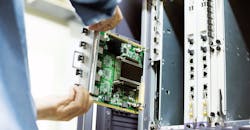Graphcore, one of the top startups selling chips custom-made for artificial intelligence, has added another $150 million in funding led by financial asset firms and investment funds, as it looks to lure customers in the market and challenge its leaders Intel and Nvidia. The funding brings its total amount raised to about $450 million since it was founded in 2016.
The boom in artificial intelligence is upending the global chip business. Nvidia has leaped out to the lead in chips designed for deep learning in data centers. It has rolled out graphics processing units, or GPUs, containing thousands of simple cores that can perform parallel computations at once. These chips carry out artificial intelligence jobs faster than central processing units (CPUs), which use small clusters of complex cores.
Nvidia sells Volta GPUs that are the gold standard for the training part of deep learning. In training, the computer combs through huge amounts of video, audio, or other data to pinpoint patterns. Training leads to inferencing, where the machine learning model runs through what it learned to identify faces or understand and respond to questions. Intel commands most of the market share in inference with Xeon CPUs used in data centers.
Graphcore is trying to dethrone Intel and other rivals with its intelligence processing unit, or IPU, which is designed from the ground up for both training and inferencing. The Colossus IPU offers more than 10 times faster performance than Nvidia Volta GPU and Intel Xeon CPUs, according to Graphcore. The chipset contains thousands of cores and large amounts of memory to stash the machine learning model inside the processor.
Sales of these types of server chips are estimated to grow from $4.2 billion in 2019 to $10 billion in 2024, according to ABI Research. The company is also trying to leap ahead of other startups racing to roll out chips for handling artificial intelligence in public cloud servers and data centers. They include Cerebras Systems, Wave Computing, Groq, and Habana Labs, which have raised billions of dollars of venture investment in recent years.
Graphcore landed $200 million in its Series D funding round more than a year ago. The startup is currently valued at $1.95 billion, establishing it as one of the only unicorns in the semiconductor industry today. It has raised funding from investors Sequoia Capital, Atomico, Bosch, Microsoft, Samsung, Dell Technologies, and top researchers in artificial intelligence, including Demis Hassabis, Greg Brockman, as well as Zoubin Ghahramani.
Microsoft, the world's second largest player in the public cloud, has started giving other companies the ability to rent out Graphcore's IPUs through its Azure cloud service.The IPUs are packaged in pairs on PCIe cards that customers can slots into its data centers. Graphcore has also introduced a set of programming tools based on its Poplar software stack, which can be used to port existing machine learning models to its new hardware.
"Demand for our IPU products is increasing amongst new and existing customers," said Nigel Toon, chief executive officer and founder of Graphcore, in a statement last month. "Investment in R&D remains a priority," he added. "Customer engineering teams and field and support engineering teams are ramping fast to keep pace with customer growth. We have expanded all of our facilities and opened in new geographies," he said.
Graphcore doubled its headcount over the last year and started scaling its operations in China, where the largest public cloud vendors by market share are Alibaba, Tencent, and Baidu. The investment gives Graphcore more than $300 million in cash on hand, which it said would be used to boost research and development and expand its footprint globally. The company's other founder is chief technology officer Simon Knowles.
The funding — the second part of its Series D round — came from new investors Baillie Gifford, Mayfair Partners, and M&G Investments, in addition to previous investors.
About the Author
James Morra
Senior Editor
James Morra is the senior editor for Electronic Design, covering the semiconductor industry and new technology trends, with a focus on power electronics and power management. He also reports on the business behind electrical engineering, including the electronics supply chain. He joined Electronic Design in 2015 and is based in Chicago, Illinois.

